





Olifantsrups & Avondrood (Deilephila elpenor)
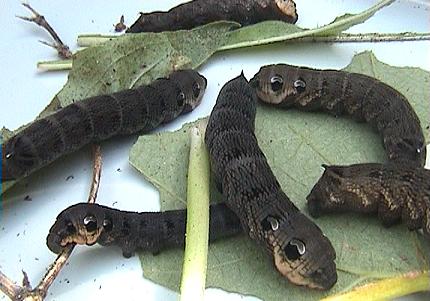







In de natte, koele zomer van 2000 was er een ware invasie van "olifantsrupsen" in mijn tuin. Ik heb er ongeveer 12 gevangen, waarvan er eentje door onbekende oorzaak stierf, een paar door mij bij waardplanten zijn vrijgelaten toen ze popgedrag begonnen te vertonen, en 9 zijn verpopt in een plexiglazen bak waarin ik ze had opgekweekt op bladeren van Onagraceae (fuchsia's, teunisbloem, basterdwederik) en druivenblad. De rups komt ook op wijnranken voor (foto rechts), hij heet in 't Duits zelfs "Weinschwärmer" (wijnpijlstaart). Mijn ervaring was, dat de dieren op druivenblad enige last van constipatie kregen waardoor ze hun ontlasting achter zich aansleepten - dus toen heb ik ze maar weer op de basterdwederik en teunisbladeren gezet.
Hun "kooi" was een doorzichtige plastic bak, die ooit als groentenla in een koelkast dienst had gedaan, met een deksel dat zodanig kon worden afgesloten dat er geen rups kon ontsnappen maar wel voldoende lucht in kon komen. Een laagje droge aarde op de bodem van ongeveer 2.5 cm waarop de bladeren werden gelegd - uiteraard moest dit verblijf regelmatig worden verschoond en het voedsel ververst.
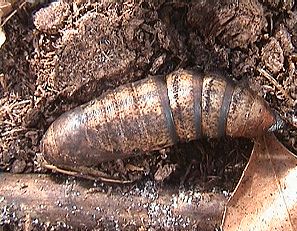

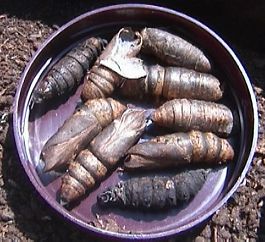

Midden tot eind september gingen de rupsen zich verpoppen. Eerst stopten ze met eten, loosden wat dunne ontlasting, en kropen onder wat blad om zich in te spinnen, zodat het eigenlijke verpoppen voor mijn ogen verborgen bleef. Toen dit zover was, had ik stevige afgevallen bladeren van laurierkers neergelegd, die niet gingen schimmelen. Gedurende de winter bleef de bak in de schuur staan, bij een lage temperatuur maar vorstvrij.
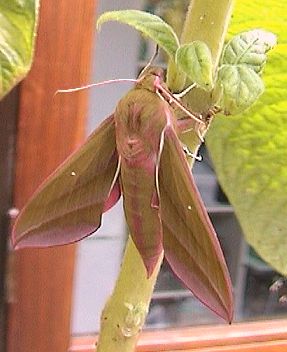
 Eind mei kwamen er zeven poppen uit - vrij kort na elkaar. Nu had ik eindelijk de kans de mooie karmijnrose vlinders goed te bekijken en te filmen/fotograferen. Helaas heb ik geen enkele op het moment van uitkomen kunnen betrappen.
Eind mei kwamen er zeven poppen uit - vrij kort na elkaar. Nu had ik eindelijk de kans de mooie karmijnrose vlinders goed te bekijken en te filmen/fotograferen. Helaas heb ik geen enkele op het moment van uitkomen kunnen betrappen.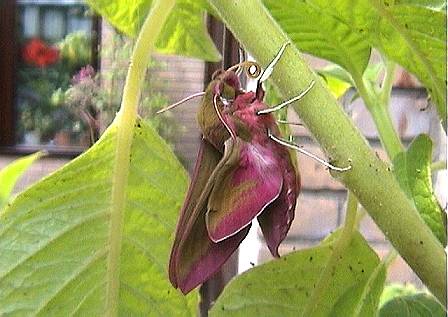
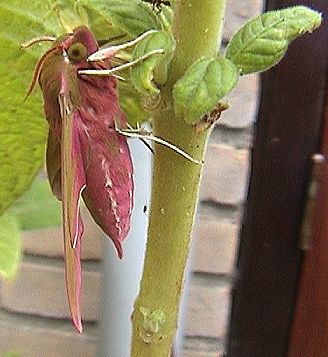
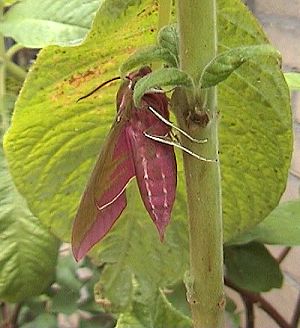
Zij- en onderkant van Avondrood. De vlinder vliegt alleen 's nachts, maar sommige komen overdags uit de pop. Op de foto links is duidelijk een oog te zien. Het bestaat uit duizenden facetten.








In the wet, chilly summer of 2000 there was a true invasion of elephant-caterpillars in my garden.
I caught about 12; one died by causes unknown, a few others I released close to their hostplants when they showed pre-pupating behaviour, and 9 pupated in a terrarium of plexiglass in which I had reared them on leaves of Onagraceae (fuchsia, evening primrose, willowherb) and grape-leaves (photo right). The caterpillar also lives on vines, in German its name is even "Weinschwärmer" (winehawk). However, I noticed that the animals got some constipation when eating grape-leaves, which caused them to drag their excrements behind them - so I fed them on evening primrose and willowherbs again.
Their "cage" was a plastic box that had been used as a drawer in a fridge that had been disposed of, with a lid that could be closed letting in fresh air but not letting out any caterpillars. I put the leaves on an inch of dry soil on the bottom - it goes without saying that this accommodation had to be cleaned regularly, and fresh food brought in every day.




By the end of September the big caterpillars started to pupate. First they stopped eating, lost some thin excrements, and crept under some dry leaves where they cocooned unseen, so that the great mystery of pupating stayed hidden from my eyes. By this time I had put some dry leathery bay-cherry leaves in the cage, that wouldn't become mouldy. During winter it stayed in the back-kitchen, at a low temperature but frost-free.

 By the end of May seven chrysalides came out - shortly after one another. At last I got the chance to have a good look at the carmine-pink moths and put them on film and photos. To my regret I couldn't catch any of them
just coming out of the cocoon. After emerging it took about a day before the moths could fly well; some of them had somewhat retarded wings (picture on the right), which prevented them from flying properly; they sort of fluttered
low above the ground with a whirring sound. One of these flutterers which I'd lost sight of, suddenly dashed along humming, over my feet in the direction of some plants. Landed on a fuchsia from the winterstorage, it climbed upward fluttering, to the
top of the plant and then dropped to the ground, buzzed upward along the next plant, pausing every now and again - then the moth quickly pushed its pointed abdomen against the plant and buzzed on, falling down and fluttering upwards again.
By the end of May seven chrysalides came out - shortly after one another. At last I got the chance to have a good look at the carmine-pink moths and put them on film and photos. To my regret I couldn't catch any of them
just coming out of the cocoon. After emerging it took about a day before the moths could fly well; some of them had somewhat retarded wings (picture on the right), which prevented them from flying properly; they sort of fluttered
low above the ground with a whirring sound. One of these flutterers which I'd lost sight of, suddenly dashed along humming, over my feet in the direction of some plants. Landed on a fuchsia from the winterstorage, it climbed upward fluttering, to the
top of the plant and then dropped to the ground, buzzed upward along the next plant, pausing every now and again - then the moth quickly pushed its pointed abdomen against the plant and buzzed on, falling down and fluttering upwards again.


Side-view and underside of Elephant Hawkmoth. Only night-flying, but some emerge from the cocoon by day. In the picture left you clearly can see the eye. It consists of thousands of facets.






